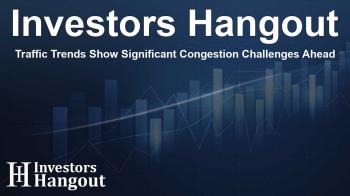Traffic Trends Show Significant Congestion Challenges Ahead

Understanding the Growing Traffic Congestion Crisis
The INRIX 2024 Global Traffic Scorecard has unveiled alarming trends in traffic congestion, indicating that many metropolitan areas are experiencing a significant uptick in delays. As employees increasingly return to city centers, the consequences of urban traffic dynamics have become more pronounced.
Key Findings of the Traffic Scorecard
In the latest report, ten U.S. cities have made it to the list of the 25 most congested urban areas globally. This development mirrors the trend of heightened activity in downtown regions as more people return to workspaces and engage in leisure activities during weekends.
Changes in Commuting Patterns
The report highlights that most major U.S. metropolitan areas, approximately nine out of ten, recorded an increase in trips to downtown regions. Notably, Downtown Houston saw a staggering 25% rise in trips, followed by Chicago at 13%, Dallas at 12%, and Atlanta at 10%. This shift is indicative of a larger trend wherein weekend evenings have seen increased traffic activity, indicating a revitalization of urban life.
Economic Impacts of Traffic Delays
The economic implications of these traffic conditions are significant. In 2024, American drivers lost an average of 43 hours annually to traffic congestion, translating into wasted productivity worth about $771 per person. In major congested cities like New York and Chicago, drivers endured even greater losses —up to 102 hours and costs exceeding $1,800 in time lost yearly.
Urban Centers Rejuvenating with Activity
Expert analysis points to the resurgence of urban life, particularly during weekends. “Every year since 2020, traffic gradually rises towards pre-pandemic levels,” remarked Bob Pishue, a transportation analyst at INRIX. This trend is a positive indicator for metropolitan economies, suggesting a revival in downtown activities, leading to a favorable impact on local businesses even as congestion presents challenges.
The Most Congested Urban Areas in the U.S.
As traffic patterns continue to evolve, examining which urban areas struggle the most with congestion can offer insights into the challenges ahead. For instance, cities such as New York, Chicago, and Los Angeles consistently rank amongst the hardest hit, often incurring substantial economic losses due to their high levels of congestion.
Strategies for Mitigating Congestion
Combating traffic congestion requires innovative approaches, leveraging data to create a more intelligent transportation system. INRIX emphasizes the importance of utilizing big data and analytics to tackle urban mobility challenges. This ongoing commitment to improvement can aid city planners in making informed decisions to optimize traffic flow and reduce delays.
Lifting Urban Mobility Through Technology
By integrating sophisticated data solutions, urban centers can address various facets of transportation issues, from traffic signal management to parking strategies. INRIX’s data on mobility, traffic patterns, and population movements enables cities to implement effective strategies that can ultimately enhance urban living.
Global Comparisons and Challenges
Interestingly, while U.S. cities have experienced increased delays, some international cities have faced even greater challenges. For instance, numerous cities outside of the U.S. have observed double-digit increases in traffic delays, underscoring the global nature of urban mobility issues.
Conclusion: Navigating the Future of Urban Mobility
The key findings from the INRIX 2024 Global Traffic Scorecard present critical benchmarks for urban areas. With insights gathered from various metropolitan regions, city leaders can monitor progress year-over-year in addressing traffic congestion and enhancing urban mobility strategies.
Frequently Asked Questions
What is the primary focus of the INRIX 2024 Global Traffic Scorecard?
The scorecard highlights trends in traffic congestion and commuting behaviors across nearly 1,000 cities in 37 countries.
Which cities rank as the most congested in the U.S. according to the report?
New York City, Chicago, and Los Angeles are consistently noted among the most congested cities.
How much time do U.S. drivers spend in traffic congestion annually?
On average, drivers lost about 43 hours each year to traffic congestion, equivalent to a full work week.
What has driven the increase in downtown trips?
The return of employees to offices and increased weekend activities have contributed to more trips into downtown areas.
How can cities combat the congestion crisis?
Utilizing data and technology to create efficient transportation systems is essential in managing congestion effectively.
About Investors Hangout
Investors Hangout is a leading online stock forum for financial discussion and learning, offering a wide range of free tools and resources. It draws in traders of all levels, who exchange market knowledge, investigate trading tactics, and keep an eye on industry developments in real time. Featuring financial articles, stock message boards, quotes, charts, company profiles, and live news updates. Through cooperative learning and a wealth of informational resources, it helps users from novices creating their first portfolios to experts honing their techniques. Join Investors Hangout today: https://investorshangout.com/
Disclaimer: The content of this article is solely for general informational purposes only; it does not represent legal, financial, or investment advice. Investors Hangout does not offer financial advice; the author is not a licensed financial advisor. Consult a qualified advisor before making any financial or investment decisions based on this article. The author's interpretation of publicly available data shapes the opinions presented here; as a result, they should not be taken as advice to purchase, sell, or hold any securities mentioned or any other investments. The author does not guarantee the accuracy, completeness, or timeliness of any material, providing it "as is." Information and market conditions may change; past performance is not indicative of future outcomes. If any of the material offered here is inaccurate, please contact us for corrections.
